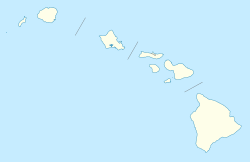Ulupō Heiau State Historic Site facts for kids
Quick facts for kids |
|
|
Ulupō Heiau
|
|

Top side of heiau platform
|
|
| Nearest city | Kailua, Hawaii |
|---|---|
| Area | 2 acres (0.81 ha) |
| NRHP reference No. | 72000425 |
| Added to NRHP | November 9, 1972 |
Ulupō Heiau is an ancient Hawaiian temple located in Kailua, Hawaiʻi, on the edge of the Kawai Nui Marsh. A heiau (pronounced HEY-ow) is a sacred place of worship for ancient Hawaiians.
Legends say that the mythical menehune people built Ulupō Heiau. Later, powerful chiefs of Oʻahu, like Kakuhihewa in the 1400s and Kualiʻi in the late 1600s, used this important site. The heiau was likely most important around 1750. It was left empty after Oʻahu was taken over in the 1780s.
In 1954, Ulupō Heiau became a park for the territory of Hawaii. Parts of it were fixed up in the early 1960s. In 1962, a special bronze sign was put there by the State Commission on Historical Sites. The heiau was officially added to the National Register of Historic Places in 1972, recognizing its historical value.
What is Ulupō Heiau?
The main part of Ulupō Heiau is a huge stone platform. It measures about 140 feet by 180 feet. Its outer walls are up to 30 feet high! The large size of the heiau shows how important it was to the culture. It also shows the great power of the chiefs who supported its building. Many of the stones used to build it might have come from Kualoa, which is more than 10 miles away.
How Was the Heiau Used?
Ulupō Heiau probably started as an agricultural heiau, called a mapele. These temples were used to help crops grow. Springs near the heiau fed fields of taro, bananas, sweet potatoes, and sugarcane. The nearby Kawai Nui pond, which is about 400 acres, was full of fish like mullet.
Later, a famous warrior chief named Kualiʻi might have changed it into a luakini. This was a different type of heiau used for important ceremonies and sacrifices. A luakini would have an altar, a tall oracle tower called an anuʻu, and thatched buildings called hale. There would also be wooden images called kiʻi representing gods.
Kailua's Historical Importance
Kailua was a very important place for political power in the Koʻolaupoko area of Oʻahu. It had plenty of fish from the pond, watered fields for farming, and places for canoes to land. Kailua often competed with Waialua for control of the entire island of Oʻahu.
After defeating the Oʻahu chief Kahahana in the 1780s, Maui chief Kahekili lived in Kailua. Later, after he conquered Oʻahu in 1795, Kamehameha I also lived there. In the mid-1800s, Queen Kalama, who was married to Kamehameha III, inherited most of the land in Kailua. Much of this land was bought in 1917 by Harold Kainalu Long Castle for his Kaneohe Ranch. When Kaneohe Ranch took over the land, it brought changes to the area because of animal grazing and ranching.
Gallery
-
A view across the Kawai Nui Marsh from the garden area
-
A traditional Hawaiian kalo (taro) patch, called a loʻi






